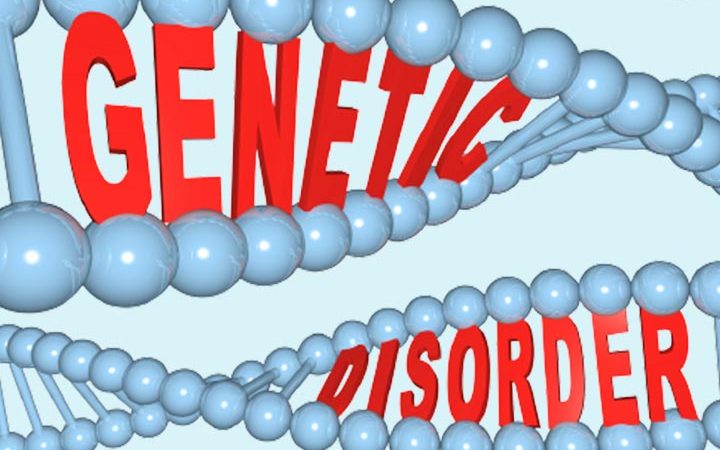Childhood genetic disorders are health problems that occur when a gene (or genes) cannot express itself properly. These conditions may either be inherited from parents or happen only in the children (if genes get altered before birth).
Genetic disorders may result from a change in one gene on a chromosome, a missing part in a chromosome, a shift in genes from one chromosome to another, an extra or missing chromosome, or an extra or insufficient sex chromosome (1). The disorders may be mild or severe, and it is estimated that around six out of ten people deal with a health condition that has a genetic reason behind it (2).
Read about different genetic disorders in children, their causes, symptoms, diagnosis, and treatment.
Common Genetic Disorders In Children
1. Down syndrome
Down syndrome is also called Trisomy 21 because children with this syndrome have an extra copy of the 21st chromosome. This affects the child’s development and causes mental and physical challenges. Down syndrome is the most common chromosomal condition in the US: it occurs in around one in every 700 children (3).
Causes and risk factors of Down syndrome
The extra chromosome 21 causes Down syndrome in children; however, researchers are unsure what causes the extra chromosome. It is believed that the mother’s age might increase the risk of Down syndrome. A woman above 35 is at a greater risk of having a baby with Down syndrome. However, this may not be correct since most women below 35 also have babies with Down syndrome (3).
Symptoms of Down syndrome
Some common physical symptoms of Down syndrome are (4) (3):
- Flattened face and nose
- Short neck with extra skin at the back
- Poor muscle tone
- Loose joints
- Almond-shaped slanting eyes
- Small head, ears, and mouth
- Iris on eyes have white spots
- Short height
- Small hands and feet
- Short fingers
- A groove between the first and second toes
- Slow physical growth
- Delay in reaching milestones
Common cognitive and behavioral challenges that children with Down syndrome experience are (4):
- Short attention span
- Slow in learning
- Delay in language and speech development
- Impulsive behavior
- Inability to judge
Diagnosis of Down syndrome
The diagnosis of Down syndrome includes prenatal screening and prenatal diagnostic testing (3) (5).
- Prenatal screening tests: These tests indicate the likelihood of a fetus having Down syndrome; however, it does confirm the presence of the disease.
-
- Both blood test and ultrasound (in the first and second trimesters)
- Prenatal diagnostic tests: If the screening tests give positive results, they are confirmed with the help of the following diagnostic tests.
-
- Chorionic villus sampling (examines cells from the placenta)
-
- Percutaneous umbilical blood sampling (examines blood from the umbilical cord)
These tests might increase the risk of miscarriage.
Treatment for Down syndrome
Early intervention programs (programs and therapies provided to children from a young age) may help children with Down syndrome deal with their condition more efficiently and reach their full potential. Some therapies that help children with Down syndrome are (6):
- Physical therapy (activities to develop motor skills and muscle strength)
2. Fragile X syndrome
Fragile X syndrome is a genetic disorder that affects males with more severity than females. According to the research, one in 7,000 males and one in 11,000 females are diagnosed with this condition.
Cause of Fragile X syndrome
Fragile X syndrome happens when there is a mutation (change in the gene structure) in a gene (FMR1 gene) located on the X chromosome. This gene makes a protein called FMRP, which is required for brain development. However, due to the mutation, this protein is not formed in a child having this condition (7).
Symptoms of Fragile X syndrome
Children with this disorder experience developmental delays, learning disabilities, and social and behavioral challenges.
Some symptoms of Fragile X syndrome in children are (7):
- Inability to sit, walk or talk at the correct age
- Difficulty in learning new skills
- Inability to make eye contact
- Being hyperactive
- Inability to pay attention
- Speaking or acting without thinking
- Male children have intellectual disabilities, while females have normal intelligence or slightly less intellectual abilities.
The risk of autism spectrum disorder increases in children with Fragile X syndrome.
Diagnosis of Fragile X syndrome
Fragile X syndrome is diagnosed with the help of a blood test. The test also detects the changes in the FMR1 genes that cause the condition (7).
Treatment for Fragile X syndrome
- There is no cure for Fragile X syndrome; however, therapies help children learn basic skills like talking, walking, or communicating with others.
- Medicines are advised to control behavioral problems.
- Healthcare providers, parents, teachers, therapists, coaches, and childcare providers should come together and develop an effective plan to help the child (7).
3. Cystic fibrosis
Cystic fibrosis is a genetic disease that affects children’s respiratory, reproductive, endocrine, and digestive systems. Around 30,000 people in the US and 70,000 people worldwide are affected by this condition (8).
Causes of cystic fibrosis
Cystic fibrosis is caused by the mutation in the gene responsible for making cystic fibrosis transmembrane regulator protein. If children inherit two copies of the defective gene (one from each parent), they express the symptoms of cystic fibrosis; otherwise, they remain a carrier.
The defective gene is responsible for making thick and sticky mucus that hinders the body’s normal functioning.
The mucus
- clogs the lungs, causing infections.
- blocks pancreas, hindering its normal functions and production of insulin.
- clogs the male reproductive system, making males sterile (8).
Symptoms of cystic fibrosis
In some children, the symptoms of cystic fibrosis are seen right after birth, but in others, they may be seen later.
Some common symptoms are (8) (9):
- Lung infections, cough, and wheezing
- Shortness of breath
- Frequent bowel movement
- Bulky, greasy, and foul-smelling stools
- Salty sweat
- Poor growth in height
- Less weight gain
- Some children may have nasal polyps (tissue growth inside the nose), sinus, and fatigue.
Diagnosis of cystic fibrosis
Cystic fibrosis is diagnosed by newborn screening in most children. If the test results are positive, these children undergo a sweat test or genetic testing.
A sweat test is the most common painless diagnostic test for cystic fibrosis. In this test, a small electrode is placed on the child’s arm, and sweat is collected to measure the amount of chloride. If the level of chloride is high, the child has cystic fibrosis.
Source: Cincinnati Children’s
mmol/L: millimoles per liter
Most children with cystic fibrosis are diagnosed before the age of two; however, others with milder symptoms are not diagnosed until they reach adolescence (8) (9).
Treatment of cystic fibrosis
Cystic fibrosis is a life-long disease, but healthcare providers advice effective disease management strategies. These are (8) (9):
- Physical exercises, breathing exercises, nebulizer, and chest physical therapy help loosen and clear the mucus.
- Washing hands regularly, staying away from sick people, and taking preventive antibiotics help prevent lung infections.
- Enzymes help digest the food. Breastfeeding children need enzymes too.
- Multivitamins and a plenty of salt through food could help too.
4. Thalassemia
Thalassemia is a genetic blood disorder, inherited from parents, which causes the body to produce less hemoglobin. This affects the body’s oxygen-carrying capacity. This condition is most common in Italy, Greece, the Middle East, Asia, and Africa (10).
Causes of thalassemia
Hemoglobin is made of two proteins: alpha-globin and beta-globin. Thalassemia occurs when there is a mutation in the gene or genes that produce these proteins.
The two main types of thalassemia are (11):
- Alpha thalassemia (gene or genes producing the alpha-globin are mutated)
- Beta thalassemia (gene or genes producing the beta-globin are mutated)
Symptoms of thalassemia
Since thalassemia affects the production of hemoglobin, many symptoms arise due to the lack of oxygen in the body.
Some mild to moderate symptoms are (10):
- Slow growth and development
- Fatigue
- Delay in reaching puberty
- Brittle bones
- Enlarged spleen
Severe symptoms of thalassemia are (10):
- Pale appearance
- Dark urine
- Loss of appetite
- Yellow tint of eyes or skin (jaundice)
- Problems with facial bones
- Enlarged heart, liver, and spleen
Diagnosis of thalassemia
Thalassemia can be diagnosed before or after birth.
- Since the disorder is inherited from parents, family genetic evaluation (blood test of family members and information about family medical history) may help diagnose it.
- After birth, certain hemoglobin tests and complete blood count help diagnose the condition. The blood of the affected children has smaller red blood cells. Most moderate to severe thalassemia conditions are diagnosed before the age of two (10).
Treatment of thalassemia
Children with mild thalassemia do not require any treatment. However, those with moderate to severe conditions require different treatments based on the severity.
- Blood transfusion
- Iron chelation therapy (removing extra iron from the body)
- Folic acid supplements
In rare cases, stem cell or bone marrow transplants may also help treat the disease.
In addition, a healthy lifestyle and regular follow-up help manage the condition effectively (10).
5. Huntington’s disease
Huntington’s disease in children (juvenile Huntington’s disease) is a genetic disorder that causes brain cells to break down at certain places. This gives rise to emotional problems, intellectual disabilities, and uncontrolled movements of hands, feet, and face.
Children mostly inherit the gene mutation from their father, and sometimes, from their mothers. The disease is progressive, and children with juvenile Huntington’s disease do not survive for more than 10 to 15 years after the onset of symptoms (12).
Causes of Huntington’s disease
Juvenile Huntington’s disease is an autosomal dominant disorder because one copy of the defective gene is enough to cause the condition.
The disease is caused by the mutation in the HTT gene, which is responsible for making the huntingtin protein (a protein essential for nerve cells in the brain). Improper functioning of this protein causes the death of nerve cells in certain areas of the brain (12).
Symptoms of Huntington’s disease
Once the symptoms of the disease show up, they usually worsen. Some of these symptoms are (12):
- Chorea (uncontrolled movements)
- Change in emotions
- Loss of thinking and reasoning abilities, leading to a decline in school performance
- Change in the personality
- Tremors and muscle twitching
- Stiff leg muscles
- Slowed (or slurred) speech
- Coordination problems
- Difficulty in swallowing
- Feeling of anger, sadness, and fear
- Seizures (uncontrolled electrical disturbance in the brain cells)
Diagnosis of Huntington’s disease
The disease is diagnosed by pediatric neurologists. They first perform a physical examination to check the symptoms. Then, they evaluate the family history to find out if any other member has the disease. Some tests that help rule out the disease are (13):
- Blood test
- Genetic testing
- Imaging tests (magnetic resonance imaging and computed tomography scan)
Treatment for Huntington’s disease
Currently, there is no treatment for the disorder. The treatment options available focus on relieving the symptoms and improving the quality of life. Since the disease affects children in several ways, a multidisciplinary treatment approach is followed. Some of these are (13):
- Physical therapy and counseling
- Genetic counseling
- Occupational therapy
- Drugs such as tetrabenazine and haloperidol control chorea.
- Antidepressants such as fluoxetine treat depression.
- Antipsychotic drugs such as olanzapine help relieve agitation and hallucinations.
Mood-stabilizing drugs such as lithium can reduce anxiety and mood swings.
6. Tay-Sachs Disease
Tay-Sachs disease is a genetic disorder that affects the brain and spinal cord of a child. The condition occurs when a gene for Tay-Sachs disease is inherited from both the parents. This means both parents need to be carriers of Tay-Sachs disease for it to manifest in their children. Children with this disease usually die by four from complications of pneumonia (14).
Causes of Tay-Sachs disease
Children with Tay-Sachs disease lack an enzyme called hexosaminidase A, a protein that causes chemical reactions in cells. As a result, fatty substances begin to collect due to the lack of this enzyme and lead to Tay-Sachs symptoms, such as muscle weakness (14).
Symptoms of Tay-Sachs disease
The symptoms become noticeable when children are around three months old. These symptoms progress with age, and children start to lose their ability to reach their developmental milestones. The symptoms for Tay-Sachs disease at different stages are (14):
At around three to six months
- Increase in surprised response
- Low muscle tone and muscle weakness
- Myoclonic jerks when falling asleep (sudden involuntary muscle jerk)
At around six to ten months
- Decrease in eye movement and eye contact
- Inattentiveness
- Losing the ability to sit
- Not reaching developmental milestones
- Red spot in the eye
At around eight to ten months
- Decreased movement and response
- Loss of vision
- Beginning of seizures
Diagnosis of Tay-Sachs disease
- Healthcare providers diagnose the disease through a blood test. If the level of hexosaminidase A is completely nil, it indicates Tay-Sachs disease.
- Eye exam to check the red spot in the eye (14).
Treatment for Tay-Sachs disease
There is no treatment for this disease. Medications may be given to children to help reduce seizures. Affected children should also be provided proper nutrition and hydration (14).
7. Cleft lip and palate
The cleft lip and palate are split in babies’ upper lip or palate when they are born. This split can be small or large and happens when babies are not formed properly early in pregnancy.
For some, it may not be noticeable since it is inside the mouth, and for others, the opening might lead to the nasal cavity (15).
Causes of cleft lip and palate
A child’s skin and bone of the upper jaw, nose, and mouth fuse to form the lip and palate during six to ten weeks of pregnancy. If the formation does not occur properly, it may lead to a cleft in the lip or palate.
Researchers are not sure what affects the formation of lip and palate in some children. It may be related to some genetic and environmental factors. The environmental factors that increase the risk of this congenital disability are (15) (16):
- Intake of certain medications during pregnancy
- Inadequate vitamin B and folic acid during pregnancy
- Exposure to certain chemicals during pregnancy
- Smoking, consuming alcohol, and drug intake during pregnancy
- Family history (parents with a cleft lip or palate)
Symptoms of cleft lip and palate
The symptoms of cleft lip and palate in children are (15) (16):
- Lip is not completely closed.
- Roof of the mouth (palate) is not completely closed.
- Both lip and palate are not completely closed.
Children with cleft lip and palate may experience complications such as:
- Difficulty in feeding
- Speech problems
- Ear infections and loss of hearing
- Dental problems
Diagnosis of cleft lip and palate
A cleft lip or palate can be diagnosed through a routine ultrasound test during pregnancy or baby’s first physical examination after birth (15) (16).
Treatment of cleft lip and palate
A cleft lip and palate can be corrected with the help of a surgery called cheiloplasty (15) (16).
- Lip cleft may be corrected when the child is around three to six months.
- Palate cleft may be corrected when the child is around 10 to 14 months.
8. Turner syndrome
Turner syndrome is a congenital genetic disorder that affects only females. It happens in around one out of 2500 females worldwide. Affected individuals are short in height and have problems with periods and breast development (17).
Causes of Turner syndrome
Turner syndrome is an inherited disease where one of the parents passes a defective gene (mutated gene) to the offspring. In a female child affected by this condition, one of the two X chromosomes is incomplete or missing (17).
Symptoms of Turner syndrome
Most females with this condition are short, with an average height of around four feet eight inches. The other symptoms are (17):
- Improper breast development
- Absence of menstruation
- Small ovary with functional impairment
- No puberty
- Absence of sex hormones
- Broad chest
- Dental problems
- Eye problems
- Scoliosis (spine curved towards the side)
- Several moles on the skin
- Narrow nails of fingers and toes
- Small lower jaw
- Swollen hands and feet
- Short and wide neck with extra skin folds
- Developmental delays (clumsiness, problems with memory, attention, planning, and management)
Diagnosis of Turner syndrome
- Parents can detect the condition by looking at the physical symptoms of their children, such as swollen hands and feet, webbed neck, and inadequate growth.
- A genetic test called the karyotype analysis is used to confirm the presence of the condition. It uses a blood sample of the affected child to examine the X chromosomes.
- Complete heart evaluation since people with this syndrome have heart problems (17).
Turner syndrome may be diagnosed before the birth of a child through the following tests (17):
- Maternal serum screening (blood of the mother shows chromosomal problems)
- Amniocentesis and chorionic villus sampling (checks amniotic fluid and tissue from the placenta, respectively)
Treatment of Turner syndrome
The treatment of the condition depends on the problems children are experiencing. Some common treatment options are (17):
- Human growth hormone injections to increase the height of children.
- Estrogen therapy (female hormone) helps in the development of breasts and the initiation of menstruation.
- Cyclic progestins given at the age of 10 or 12 stimulate puberty.
9. Muscular dystrophy
Muscular dystrophy is characterized by mild to severe muscle weakness that might start at different ages in children. The two types of muscular dystrophies are Duchenne muscular dystrophy and Becker muscular dystrophy (18).
Causes of muscular dystrophy
Muscular dystrophy is passed down from parents to children. The genetic change prevents the body from making proteins required for healthy muscles (18).
Symptoms of muscular dystrophy
Some symptoms of this condition are (18):
- Clumsiness
- Trouble in climbing stairs
- Leg pain
- Weak muscles of arms, legs, and face
- Large calves
Since the symptoms of this condition are progressive, they can develop into the curved spine, heart and breathing problems, and walking issues.
Diagnosis of muscular dystrophy
Muscular dystrophies are diagnosed by (18):
- Understanding family history
- Doing physical examinations
- Blood test and genetic testing
- Muscle biopsy
- Electromyography to check whether nerves and muscles are working together
- Echocardiogram to check the heart
Treatment of muscular dystrophy
There is no cure for muscular dystrophy, but effective treatment strategies may help children stay active and independent. The treatment options are chosen based on the type and severity of the condition. Some of these options are (18):
- Physical therapies
- Support with wheelchairs and walkers
- Using braces and splints
- Medications
- Breathing support
- Scoliosis surgery
- Nutritional counseling
10. Sickle cell anemia
Sickle cell anemia is a blood disorder where the red blood cells change their shapes from round discs to the crescent moon (sickle-shaped). These sickle-shaped red blood cells get stuck in the blood vessels and block them, leading to an obstruction in the blood flow that causes pain and organ damage (19).
Causes of sickle cell anemia
Sickle cell anemia is inherited from parents. If the hemoglobin gene passed from the parents to children is defective (mutated), it will lead to the formation of defective red blood cells.
The types of gene inheritance are (19):
- If each parent passes one mutated gene, the child has sickle cell anemia.
- If one parent passes a mutated gene while the other parent passes a normal gene, the child is a carrier but does not have the disease.
- If one parent passes a mutated gene for sickle cell anemia, while the other parent passes a mutated gene for some other condition, the child has other disorders.
Symptoms of sickle cell anemia
Some symptoms of sickle cell anemia in children are (19):
- Pain in any part of the body that may last for a few hours to a few days
- Cold, stress, or illness may also cause pain
- Pale appearance
- Fatigue and dizziness
- Shortness of breath
- Irritable and inability to pay attention
- Increased heart rate
- May have jaundice if red blood cells break down faster than they are formed
Other complications of the condition are (19):
- Infection and inflammation in lungs, causing chest pain and cough
- Severe anemia
- Swelling in fingers and toes
- Risk of bacterial infections
- Enlarged spleen traps red blood cells
- Stroke
Diagnosis of sickle cell anemia
Sickle cell anemia is diagnosed soon after birth through regular newborn screening tests. This test is further confirmed by another blood test called hemoglobin electrophoresis.
The condition can also be diagnosed during pregnancy through amniotic fluid or placenta testing (a sample of placenta tissue is tested) (19).
Treatment of sickle cell anemia
Some treatment options that are still in the nascent stage are (19):
- Stem cell transplant (suitable only for some patients)
- Gene therapy (research is ongoing)
Other treatment options that help children manage their condition are (19):
- Immunizations and administration of penicillin to help prevent infections.
- Folic acid supplements help in the formation of new red blood cells.
- An everyday dosage of hydroxyurea helps make cells less sticky, thus preventing blockages in the blood vessels.
- Pain-management medications
- Blood transfusions in case of severe anemia.
There are different genetic disorders in children. Some have an effective cure, while others may be managed by early interventions, therapies, lifestyle, and medications. If you feel your child has a genetic condition, talk to the healthcare professional and determine a proper treatment plan. Addressing health problems early helps in improving their quality of life.
References:
MomJunction’s articles are written after analyzing the research works of expert authors and institutions. Our references consist of resources established by authorities in their respective fields. You can learn more about the authenticity of the information we present in our editorial policy.
The following two tabs change content below.




































